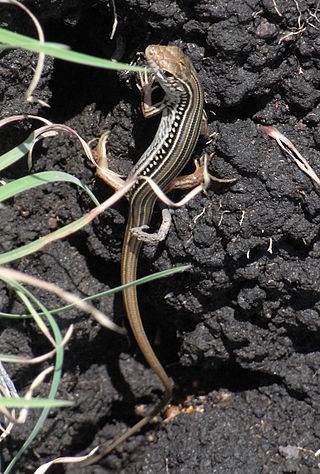
The copper-tailed ctenotus or copper-tailed skink, is a species of medium-sized skink found commonly along the eastern seaboard of Australia and throughout the country generally. Striped skinks are found in open bushland and heathland. They can grow to be 30 cm long.

The eastern striped skink is a species of skink found in a wide variety of habitats around Australia. They are long-tailed, fast moving skinks that are quite large, growing to a maximum length of about 30 cm. This skink is mostly brown with a white-edged black stripe running down the length of its back and tail with broad brown stripes along the side of the body with rows of white spots. The sides become lighter, turning into an off-white colour towards the underside of the skink, running from the groin to the chin. The striped skink is similar in appearance to the spotted-back skink with the main identifying difference being the solid stripe running down the back of C. robustus whereas C. uber orientalis has a row of dots.
The Quinkan ctenotus is a species of Australian skink, a lizard in the family Scincidae.
Ctenotus zebrilla, also known commonly as the Southern Cape York fine-snout ctenotus, is a species of skink, a lizard in the family Scincidae. The species is endemic to Australia.
Ctenotus astictus, the Arnhem striped ctenotus, is a species of skink found in Northern Territory in Australia.
Ctenotus capricorni, the Capricorn ctenotus, is a species of skink found in Queensland in Australia.

Ctenotus eutaenius, commonly known as the black-backed yellow-lined ctenotus, is a species of skink found in Queensland in Australia.
Ctenotus eurydice, also known commonly as the brown-backed yellow-lined ctenotus, is a species of skink, a lizard in the family Scincidae. The species is native to New South Wales and Queensland in Australia.

Ctenotus gagudju, the Magela ctenotus or Kakadu ctenotus, is a species of skink found in the Northern Territory in Australia.
The Kurnbudj ctenotus is a species of skink found in the Northern Territory in Australia.
The gravelly-soil ctenotus is a species of skink found in Queensland in Australia.
The Atherton ctenotus is a species of skink found in Queensland in Australia.
The Arnhem land ctenotus is a species of skink found in Northern Territory in Australia.
The beaded ctenotus is a species of skink found in Queensland in Australia.
The gravel-downs ctenotus is a species of skink found in Queensland in Australia.
Ctenotus spaldingi is a diurnal terrestrial skink (Scincidae) species of lizard, commonly known as the straight-browed ctenotus or Spalding's ctenotus. Native to Australia the species is found in the northern areas of Australia, along the east coast, in the north and east of South Australia and throughout Victoria and in southern Papua New Guinea. Their conservation status is of least concern classified by the IUCN. Individuals can be up to 30cm long from the snout to tail or 10cm long from the snout to vent (SVL). They typically inhabit grasslands and low vegetation in savannah woodlands in coastal dune areas, monsoon scrub and woodland commonly found around rock outcrops and when disturbed will hide in shallow burrows or amongst ground litter.
Ctenotus stuarti, also known commonly as the Point Stuart ctenotus or Stuart's ctenotus, is a species of skink, a lizard in the family Scincidae. The species is endemic to Australia.
The sharp-browed ctenotus is a species of skink found in the Northern Territory in Australia.
The Hinchinbrook ctenotus is a species of skink found in Queensland and Hinchinbrook Island in Australia.
The scant-striped ctenotus is a species of skink found in the Northern Territory in Australia.




